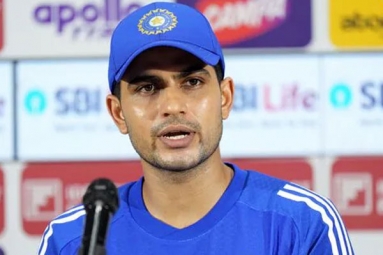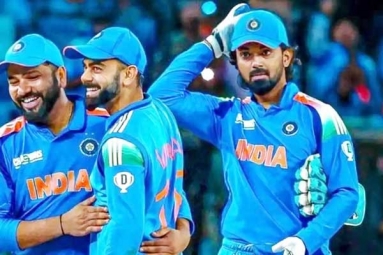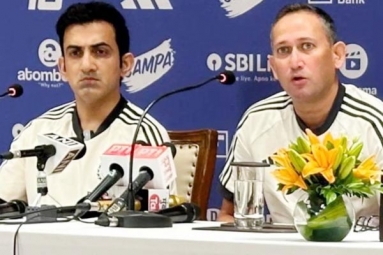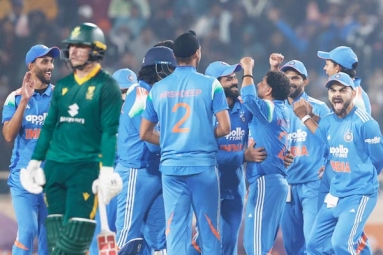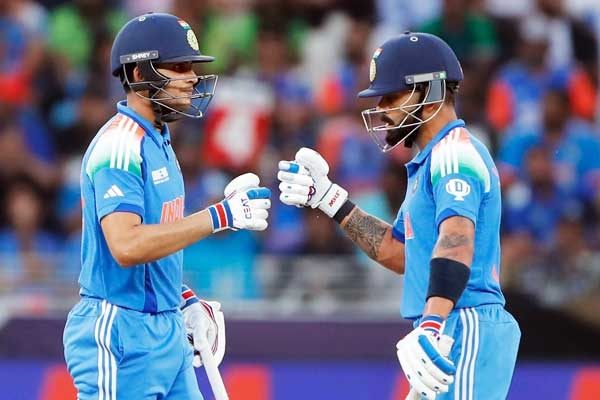
(Image source from: x.com/BCCI)
In the year's most significant match, showcasing his vulnerability like never before, Virat Kohli demonstrated that he still has what it takes. Perhaps what he has lost along the way won’t shape his legacy. He notched up 14,000 runs in One Day Internationals, celebrated his 51st century in this format, paved the way for India's semi-final qualification, and largely eliminated Pakistan's chances in the upcoming Champions Trophy 2025. The reigning champions and hosts must now rely on favorable outcomes in other matches to remain in contention. India entered the match as the clear favorites, a status they justified by restricting Pakistan to a mere 241 runs, with Hardik Pandya delivering a performance so impressive it seemed almost unfair. As an allrounder, he not only dismissed Pakistan’s leading batsman but returned to take down the team's top scorer, proving he is far more than just a name on the roster—he is a vital asset.
Kuldeep Yadav added the necessary flair to the bowling attack. His unique left-arm wrist spin is a rarity, and he enhanced this by accelerating through the air while maintaining both spin and precision. As a result, unless batsmen can read him right from his delivery, they will constantly be left guessing. This uncertainty caught three Pakistani batsmen off guard, all dismissed in the final overs of their innings. Pakistan appeared poised to finish strong, but Kuldeep thwarted their plans effectively. Despite his recent injury, he remained a formidable threat. While Pakistan managed to generate some thrilling moments—such as Shaheen Shah Afridi's 143kph inswinging yorker that bowled Rohit Sharma, and Abrar Ahmed's devastating carrom ball that dismissed a charging Shubman Gill—they failed to seize these opportunities. Consequently, this former world champion team, known for its resilience, found itself in a familiar predicament in Dubai; they may have started in trouble, but they failed to resolve it. After being at 151 for 2 in the 34th over, they crumbled to a total of 241, largely due to the impressive control exhibited by Harshit Rana, the least experienced player on the Indian side, who proved nearly impossible to hit with his slower deliveries.
What began as a historic rivalry in an ICC event ultimately turned lopsided, with the concluding moments overshadowed by an individual milestone. Axar Patel declined an easy two runs so Kohli could reach his century. The Dubai crowd relished this gesture. As India required just 12 runs for victory, the same number Kohli needed for his hundred, cheers erupted in his name. Pakistan was entirely absent from the narrative. Following a sudden collapse of three wickets for just 11 runs in 19 balls, their hopes for a successful outing quickly evaporated. Mohammad Rizwan had anticipated a much different outcome for his innings.
Frames from a blockbuster #PAKvIND : https://t.co/LNEwWktRij#ChampionsTrophy pic.twitter.com/S9YoXLXwKp
— ICC (@ICC) February 23, 2025
script async src="https://platform.twitter.com/widgets.js" charset="utf-8">
He entered the crease with his team at 47 for 2 and struck his very first delivery for four runs, subsequently opting to forgo an aggressive approach to scoring. He ended up with a total of 24 runs from 50 balls, rarely connecting with the ball forcefully. His reluctance to play aggressively was obvious. Meanwhile, Saud Shakeel was at least trying to convert the good balls he faced into singles. Upon reaching fifty, he had only faced 29 dot balls. Concurrently, Rizwan, at the opposite end, had accumulated 40 runs. India strategically withheld spin bowling at the start of his innings. However, the pitch proved to be more favorable than that of the opening match in Dubai just days prior. While it wasn’t perfectly flat, it offered more pace and improved under the lights. Nonetheless, Rizwan batted as if under a curse, seemingly fearing misfortune would follow any attempt to strike the ball hard.
And in a way, misfortune did come. Rizwan was dismissed while attempting to send Axar’s delivery over the boundary, initiating a batting collapse. Shakeel fell in the following over, and soon after, Tayyab Tahir was also out. After 320 deliveries across two matches spent searching for a middle-over wicket, India had suddenly taken three dismissals in just four balls. Pakistan’s score slid to 165 for 5 and soon deteriorated further to 200 for 7, now facing the challenge of the remaining 7.1 overs with their lower order exposed. India maintained their disciplined bowling, never allowing Pakistan to recover. Hardik led the charge, delivering short of a length on a pitch that provided some grip and a bounce reminiscent of a tennis ball. He claimed the wicket of Babar Azam while India’s main fast bowler, Mohammed Shami, was off the field due to a shin issue, and shortly afterward claimed Shakeel’s wicket right after the latter had hit a boundary off him. Hardik possessed a keen understanding of how to exploit the conditions, making batting exceptionally difficult for his opponents. Thanks to his efforts, Kuldeep and Rana combined to bowl 6.4 overs at the death, conceding only 28 runs while taking four wickets.
Gill stood out during India’s chase, consciously ensuring his front foot remained appropriately positioned, allowing him to capitalize on Afridi’s full-length deliveries when there was no swing available. When he struck the fast bowler straight down the ground, and followed it up by coming down the track to send the ball high towards the sightscreen, it appeared to be his day. However, Abrar disrupted his rhythm with a delivery that drifted in, luring Gill into closing the bat’s face, resulting in the ball turning away to shatter the middle and off stump. Gill was left completely astonished.
Kohli shrugged his shoulders in response, appearing somewhat exposed against Abrar, and nearly got bowled while attempting to defend. Yet, when facing the faster bowlers, he showcased his classic form. He elegantly surpassed the 14,000-run mark with a precise cover drive off Haris Rauf. All of Pakistan's premier bowlers present good pace, which happens to be where Kohli thrives. For a batsman of his caliber, it’s essential to unsettle him at the crease, especially when he is new to it. In his previous six ODIs, he had fallen victim to legspin five times. Pakistan had one such bowler, but they felt hesitant to utilize him against Kohli.
51st ODI Century
— BCCI (@BCCI) February 23, 2025
Updates https://t.co/llR6bWyvZN#TeamIndia | #PAKvIND | #ChampionsTrophy | @imVkohli pic.twitter.com/soSfEBiiWk
Meanwhile, Shreyas Iyer secured a half-century. A slight adjustment in his batting technique, where he holds the bat higher and creates momentum by waving it as the bowler approaches, has been beneficial in overcoming his past struggles with short balls. He demonstrated this by hitting Rauf for four in front of square. However, the limelight belonged to his more experienced partner.
Kohli was setting the pace of the innings, and Pakistan allowed him the freedom to do so. Although he struck just three boundaries in his first 62 deliveries, he had already accumulated fifty runs. He possesses the ability to score rapidly without resorting to risky shots. The ball, under the lights, had less resistance on the pitch, working to his advantage. He had a strong feeling that a hundred was on the cards. In the 42nd over, when Axar rejected a second run off a wide delivery, Kohli demanded to know why, as it seemed obvious that Axar just wanted to give Kohli the best opportunity to reach three figures before time ran out. When Kohli eventually achieved his hundred off the last ball of the match, he glanced towards the dressing room and confidently stated, "I told you. Relax." Such was the ease with which he accomplished it, and his inevitability was palpable.






